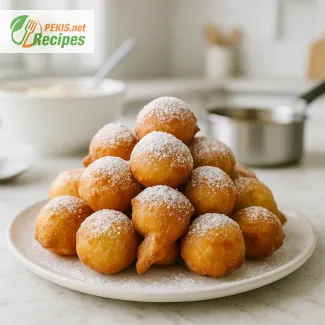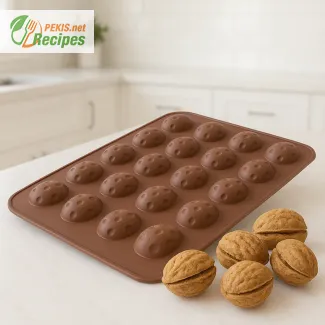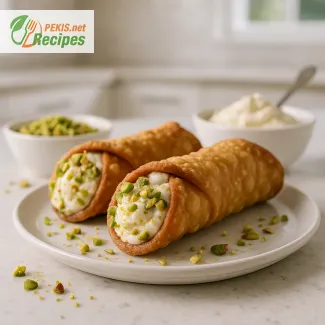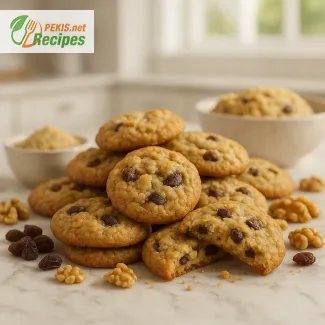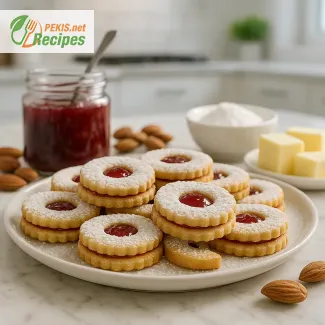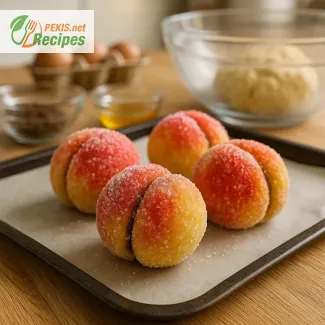
Discover the Charm of Red and Yellow Peach-Shaped Cookies
Traditional “Breskvice” as a Colorful Festive Treat
Among the most visually striking and delightfully nostalgic cookies, peach-shaped cookies, known as “Breskvice”, hold a special place in festive culinary traditions. These red and yellow sugar-coated cookies mimic the look of ripe peaches and are celebrated for their soft texture, tender flavor, and charming appearance. Originating from Central and Southeastern Europe, particularly the Balkans, they’ve gained popularity beyond their roots due to their decorative appeal and delicious taste.
What makes Breskvice so unique is not just their appearance, but the way they’re carefully crafted and assembled. Each “peach” is made by baking two small cookie halves, hollowing them slightly, and filling them with a rich, moist mixture often consisting of ground cookie crumbs, walnuts, chocolate powder, jam, and a touch of rum. The halves are then tinted in vibrant red and yellow food coloring, rolled in sugar, and joined to resemble a miniature fruit—complete with a perfectly rounded shape and glistening “skin.”
These cookies are not only eye-catching additions to dessert tables but are also considered a symbol of celebration and care. Whether served at weddings, holidays, birthdays, or cultural festivals, their presence elevates any occasion with a sense of warmth, tradition, and hospitality.
A Visual Delight with Homemade Elegance
Peach-shaped cookies are often described as a blend of art and baking. The process of shaping, coloring, and assembling them by hand brings a tactile satisfaction that goes beyond typical cookie baking. The attention to detail—matching the halves, blending the colors, rolling them in sugar—results in cookies that look deceptively like small peaches, evoking surprise and joy from guests and children alike.
The flavor complements the aesthetics. While the exterior is crisp and golden from baking, the interior is soft, moist, and aromatic, enhanced by the rum-infused filling and sometimes a hint of apricot or plum jam. The balance of textures—crunchy sugar crust, tender cookie shell, and rich center—makes each bite a complete experience.
Heritage Brought to the Modern Table
Although Breskvice are rooted in Balkan culinary heritage, they have found homes in Slovenian, Croatian, Serbian, and other Central European households. Today, more and more home bakers around the world are discovering their charm. Part of their appeal lies in their versatility—they can be customized in size, color intensity, and flavor combinations to suit the occasion or personal taste.
Modern adaptations may use natural food coloring, incorporate chopped nuts or coconut, or introduce liqueur-based fillings for an adult twist. Whether made in large batches for festive trays or as small edible gifts, they reflect time, effort, and a passion for sharing homemade beauty.
The Perfect Cookie for Special Occasions
No matter the season, red and yellow peach-shaped cookies instantly brighten up any dessert spread. They are often the first to be noticed and the fastest to disappear. Their round, delicate form mimics a peach in both look and spirit—signaling sweetness, summer, and abundance.
Perfect for wedding platters, baby showers, tea tables, and festive baking projects, they offer a unique way to express tradition through creativity. Their preparation, though detailed, is straightforward with a good recipe—and the reward is not just delicious cookies, but the joyful reactions of everyone who sees and tastes them.
Why This Recipe Stands Out
This particular Breskvice recipe delivers on authenticity, visual appeal, and homemade flavor. With a simple dough made from flour, margarine, sugar, and eggs, the cookies bake into delicate golden shells, ideal for shaping and filling. The rum-enhanced filling adds depth, while the sugar coating gives a final sparkling touch.
Making these cookies is a culinary craft worth learning and sharing. The process invites creativity, precision, and joy, whether you’re making them for your family, your guests, or your community.
- Mix the dough: In a large bowl, combine the all-purpose flour with baking powder. Add the softened margarine and crumble it into the flour using your hands until it resembles coarse crumbs.
- In a separate bowl, beat the eggs with granulated sugar and vanilla sugar until the mixture becomes light and fluffy.
- Combine the beaten egg mixture with the flour-margarine base. Knead until a smooth, soft dough forms. If the dough is too sticky, add a small amount of extra flour gradually.
- Shape the cookies: Roll small, even balls from the dough (about the size of a walnut). Place them on a baking sheet lined with parchment paper, leaving some space between them.
- Bake: Bake at 180 °C (350 °F) for approximately 20 minutes, until lightly golden. Let them cool only briefly.
- Hollow the halves: While still slightly warm, carefully scoop out a small cavity from the flat side of each cookie half using a small knife or spoon. Be gentle—if the cookies cool too much, they may crack. Reserve the scooped crumbs for the filling.
Prepare the filling:
- Grind the reserved cookie crumbs together with walnuts.
- Mix in chocolate powder, rum, a few teaspoons of sweetened water, and a small spoonful of jam. Adjust the consistency: the filling should be moist and sticky, but not runny.
Assemble the cookies:
- Fill each hollowed cookie half with a small amount of filling. Press two halves together to form a ball resembling a peach.
- Prepare two bowls with water and a few drops of red and yellow food coloring, respectively.
- Quickly dip one side of each cookie in yellow dye, and the opposite side in red. Allow excess to drip off.
- Roll the colored cookie gently in granulated sugar and place on paper towels to dry completely.
Elevating Peach-Inspired Cookies with Creative and Healthier Variations
Transforming Classic Breskvice into a Modern Delight
Traditional peach-shaped cookies, or Breskvice, are beloved for their charming appearance and soft, sweet flavor. Yet, with a few thoughtful tweaks, this recipe can be elevated into something even more memorable. Whether you're looking to enhance texture, introduce new ingredients, reduce sugar, or cater to dietary needs, there are numerous ways to build on the original while preserving its festive essence.
How ingredient changes affect taste and texture
One of the most straightforward ways to enrich this recipe is by modifying the filling ingredients. While the classic version calls for walnuts, jam, rum, and chocolate powder, you can add depth by incorporating:
- Finely chopped dried apricots or figs for natural sweetness and a chewy contrast.
- Ground almonds or hazelnuts to offer a slightly buttery, nutty aroma and smoother texture.
- A spoonful of orange zest or lemon zest, which introduces a subtle citrus note that brightens the overall flavor.
- Dark chocolate shavings or cocoa nibs, which give the filling an earthy intensity and slight crunch.
Adding a dash of cinnamon or nutmeg to the dough or filling can also transform the profile with warm, comforting spice tones, especially suitable for autumn and winter baking.
Making the recipe healthier without losing flavor
The original recipe contains a high proportion of refined sugar and margarine, which contribute to its indulgent richness. To make the cookies lighter yet still delicious:
- Replace part of the sugar with finely ground dates or maple syrup for natural sweetness and added minerals.
- Use unsalted butter instead of margarine for a cleaner, more wholesome fat source, or opt for plant-based butter alternatives with no trans fats.
- Substitute part of the white flour with whole spelt or oat flour. This will slightly change the texture—making the cookies a bit more crumbly—but will boost fiber and nutrients.
- Instead of artificial food coloring, use natural dyes like beetroot powder for red and turmeric or carrot juice for yellow.
These adaptations help reduce processed ingredients while adding nutritional value and unique flavor tones.
Why homemade always tastes better
Homemade Breskvice have the advantage of customization and freshness. Commercial versions are often mass-produced, overly sweet, or lack the delicate filling that defines the original. When made at home, each cookie is shaped and filled with care, giving you full control over texture, sweetness, and quality.
Moreover, freshly made cookies have a tender interior and crisp sugar-coated exterior that rarely survives long-term storage or transport. The aroma of vanilla, rum, and toasted nuts emerging from your own kitchen can't be replicated by packaged versions.
Common mistakes and how to avoid them
A few key errors can compromise the result of this otherwise straightforward recipe:
- Overbaking the cookie halves: leads to dry, brittle shells that crack easily during hollowing. Stick to the suggested baking time and monitor closely.
- Not hollowing while still warm: the cookies need to be scooped shortly after baking, while still pliable. Wait too long, and they’ll fracture.
- Overfilling or using too wet a filling: this makes it hard for the halves to adhere and can cause sogginess. The filling should be moist but not runny.
- Coloring with excess dye or soaking too long: which may make the cookies too soft or bitter. Dip quickly and lightly for even tones.
Enhancing presentation and flavor pairing
To truly impress with these cookies, think about presentation. Try serving them in a rustic wooden bowl or on lace-patterned paper, echoing their traditional roots. You can even insert a fresh mint leaf or clove into each cookie to mimic a peach stem, adding both visual appeal and subtle aroma.
They pair beautifully with black tea, dessert wine, or even unsweetened almond milk, which balances the richness of the filling.
Gluten-free and vegan-friendly adaptations
For those avoiding gluten, a mix of rice flour and almond flour (with xanthan gum) can work as a base—although you'll need to test proportions to ensure structure. For vegans:
- Use flax eggs (1 tbsp ground flax + 3 tbsp water per egg)
- Choose dairy-free margarine or coconut oil
- Confirm that your jam and food coloring are free from animal-derived gelatin or additives
These changes allow more people to enjoy Breskvice while preserving the spirit of the original treat.
When tradition meets innovation
Updating this classic doesn’t mean replacing it—it means honoring its history while making it your own. Whether you're keeping it close to the original or exploring new textures, fillings, and colors, peach-shaped cookies offer a canvas for creativity and tradition to meet in perfect harmony.
Allergens present in the recipe:
- Gluten: Present (from wheat flour)
- Eggs: Present
- Nuts: Present (walnuts)
- Dairy substitute: Margarine may contain milk derivatives
Tips for allergen replacements:
- Gluten-free option: Use certified gluten-free all-purpose flour blend with xanthan gum added.
- Nut-free version: Replace walnuts with oat flakes or ground sunflower seeds.
- Egg-free alternative: Use a flaxseed egg substitute (1 tbsp ground flax + 3 tbsp water per egg).
- Dairy-free version: Ensure margarine is dairy-free (check label for casein or whey).
Vitamins and minerals per serving (approximate):
- Vitamin E: 1.3 mg – supports immune function and skin health
- Vitamin B1 (Thiamine): 0.05 mg – essential for energy metabolism
- Iron: 0.5 mg – contributes to normal oxygen transport
- Magnesium: 8 mg – aids muscle function and nervous system
- Zinc: 0.2 mg – supports cell regeneration and immunity
- Calcium: 10 mg – contributes to normal bone structure
- Phosphorus: 20 mg – essential for healthy bones and teeth
Antioxidants per serving (approximate):
- Flavonoids (from walnuts and chocolate): 20 mg – protect cells from oxidative stress
- Vitamin E (tocopherols): 1.3 mg – helps combat free radicals
- Phenolic compounds (from jam and cocoa): 10 mg – support cardiovascular health and aging prevention
